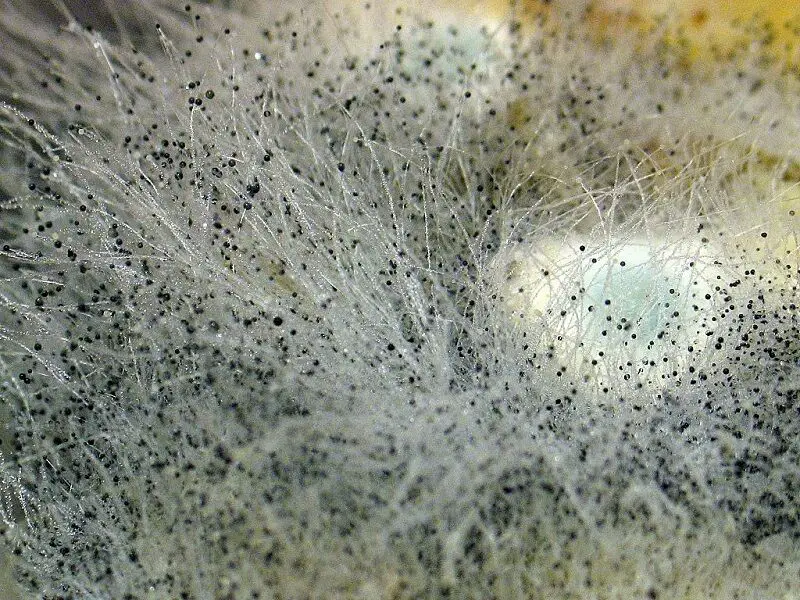Today, many people are starting to engage in the mushroom business due to its low costs and quick payback, but not everyone is aware of the possible difficulties. Any novice mushroom grower should familiarize himself with the information on how to deal with mold on mycelium when growing mushrooms because it is because of them that blocks often deteriorate.

Mold can start not only in the substrate itself but also indoors: on the floor, on the walls, on the shelves, because it also belongs to mushrooms and loves dampness.
Table of Contents
What causes mold on mycelium?
The most common types of mold that grow in mushroom blocks are neurospore (red-orange) and various types of Trichoderma (from gray to blue and green). Sometimes mushroom growers are surprised that the block was clean and “healthy” and suddenly it suddenly began to be covered with moldy spots.
In fact, the infection was in it from the very beginning. After all, for favorable development, she also needs an incubation period. And, apparently, it was listed in the block in large numbers. Mycelium can destroy small accumulations of harmful microorganisms on its own.
In order to avoid trouble in the future, the owners of mycelium need to know where the mold comes from in the substrate and in the room.
Causes of mold in mushroom mycelium subtrate blocks
There are 3 most likely factors here:
- Poor quality heat treatment of raw materials. Most likely, the temperature regimes were violated, because of which the infection did not die.
- Violation of the mode of incubation. Temperature fluctuations, improperly designed ventilation system, temperature difference at the top and bottom of the room – all this creates favorable conditions for the development of parasitic microorganisms.
- High humidity inside the blocks. When the nutrient material with mycelium is too wet, some types of moldy fungi begin to actively multiply in it.
Also, the reason for the reproduction of mold in the substrate can be its low acidity. The optimal PH balance should be 7.8-8.5. A PH level below 7 becomes an excellent environment for the life of the mold.
Causes of mold in mushroom growing room
The most likely factors for the appearance of mold in a room for growing mushrooms:
- Non-compliance with the conditions. Poor ventilation, incorrect temperature conditions or their differences, high levels of dampness – all this leads to the appearance of not only mold, but also many other problems, up to the complete death of the crop and damage to the mycelium.
- Failure to comply with sanitary standards. The mushroom room needs sterility and regular preventive treatment with antibacterial agents. If these conditions are not observed, an infection will quickly appear in the room and harmful insects, even rodents, will begin to multiply.
How to get rid of mold on mycelium?
For effective control of mold fungi, special fungicidal preparations are used in the cultivation of mushrooms. They are extremely safe and work very quickly. With timely processing, there is every chance to save the substrate blocks and get a high-quality crop of mushrooms.
List of popular drugs to get rid of mold on mycelium while growing mushroom:
- Kinto Duo. The concentrated suspension is diluted with water. The proportions are indicated in the instructions and depend on the type of culture. The fungicide is applied to the substrate, on the last day of watering on the cover. The only negative is that some types of mold quickly develop resistance to it.
- Derozal Euro . Universal highly effective fungicide, can be used both for the treatment of infected blocks and for prevention. Works against a large number of types of mold. Penetrating into plant cells, it has both a protective and therapeutic effect. The dosage is calculated based on the size of the substrate blocks.
- Topsin-M . The fungicide is available in powder form. It has a contact-systemic effect on the source of infection. Helps not only from mold, but also from certain types of parasitic insects.
- shirlan fungicide. The drug has an inhibitory effect on the fungus. Differs in high safety and the long period of action. It can be used not only for the destruction of mold, but also for prevention.
- Fundazol . The drug belongs to the II-class toxicity and should be used very carefully. However, its high efficiency allows it to remain on the list of the best drugs for fungal infections in agriculture.
For the treatment of premises, broad-spectrum preparations are used, such as Biocontact, Virocid, Gembar, Armex, Biopag-D. They help to destroy not only mold , but also bacterial and viral infections.
Conclusion
This was the basic information on how to deal with molds on mycelium when growing mushrooms. To prevent an epidemic, it is necessary to maintain complete sterility at all stages of growing food mushrooms. If you doubt that you will be able to carry out safe processing yourself, contact a special service.